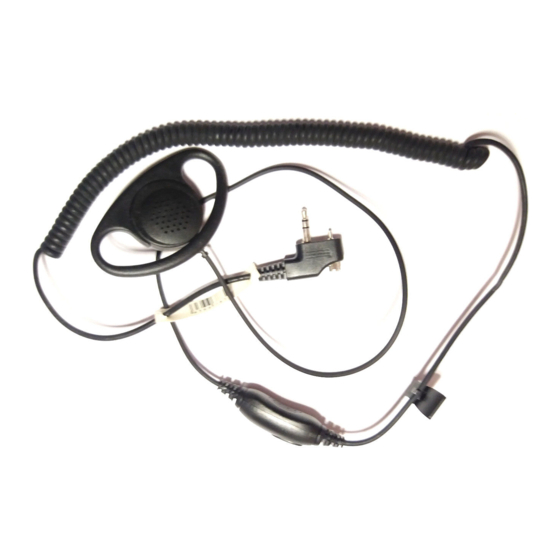Table of Contents
Advertisement
Quick Links
SP-200
FCC RF EXPOSURE COMPLIANCE REQUIREMENTS FOR OCCUPATIONAL USE
ONLY
The Federal Communications Commission (FCC), with its action in General Docket 93-62, November 7,
1997, has adopted a safety standard for human exposure to Radio Frequency (RF) electromagnetic energy
emitted by FCC regulated equipment. Maxon subscribes to the same safety standard for the use of its
products. Proper operation of this radio will result in user exposure far below the Occupational Safety and
Health Act (OSHA) and Federal Communications Commission limits.
DO NOT transmit for more than 50% of total radio use time (50% duty cycle). Transmitting more than
50% of the time can cause FCC RF exposure compliance requirements to be exceeded.
This radio is NOT approved for use by the general population in an uncontrolled environment. This radio
is restricted to occupational use, work related operations only where radio operator must have the
knowledge to control the user's exposure conditions for satisfying the higher exposure limit allowed for
occupational use.
When transmitting, hold the radio in a vertical position with its microphone 1 inches (2.5 cm)
away from your mouth.
The radio is transmitting when the red LED on the front of the radio is illuminated. You can
cause the radio to transmit by pressing the PTT bar on the radio.
These are required operating configurations for meeting FCC RF exposure compliance.
Failure to observe these restrictions mean violation.
RF EXPOSURE COMPLIANEC AND CONTROL GUIDELINES AND OPERATING
INSTRUCTIONS
• To control your exposure and ensure compliance with the occupational/controlled environment exposure
limits, always adhere to the following procedures.
Guidelines:
• Do not remove the RF Exposure Label from the device.
Operating Instructions:
• Hold the radio in a vertical position in front of face with the microphone (and the other parts of the radio,
including the antenna) at least one inch (2.5 cm) away from the nose. Keeping the radio at the proper
distance is important because RF exposures decrease with distance from the antenna. The antenna should be
kept away from eyes.
• When worn on the body, always place the radio in a Maxon Telecom approved clip, holder, holster, case,
or body harness for this product. Using approved body-worn accessories is important because the use of
Maxon Telecom or other manufacturer's non-approved accessories may result in exposure levels which
exceed the FCC's occupational/controlled environment RF exposure limits.
• Use only Maxon Telecom approved supplied or replacement antennas, batteries, and accessories. Use of
non-Maxon Telecom approved antennas, batteries, and accessories may exceed the FCC RF
exposure guidelines.
1
Advertisement
Table of Contents

Summary of Contents for Maxon SP-200
- Page 1 RF exposures decrease with distance from the antenna. The antenna should be kept away from eyes. • When worn on the body, always place the radio in a Maxon Telecom approved clip, holder, holster, case, or body harness for this product. Using approved body-worn accessories is important because the use of Maxon Telecom or other manufacturer’s non-approved accessories may result in exposure levels which...
-
Page 2: Table Of Contents
About Your SP-200 Radio Maxon's SP-200 Radio feature up to 13 groups and up to 16 channel operation per group for a total channel capacity of 199 channels of superior performance and reliability. Operation and functions for Maxon's SP-200 Radios are described in this manual. -
Page 3: Safety Information
The Federal Communications Commission (FCC), with its action in General Docket 79-144, March 13, 1985, has adopted a safety standard for human exposure to Radio Frequency (RF) electromagnetic energy emitted by FCC regulated equipment. Maxon subscribes to the same safety standard for the use of its products. Proper operation of this radio will result in user exposure far below the Occupational Safety and Health Act and Federal Communications Commission limits. -
Page 4: Sp-200 Features
5 WATT RF POW < < < < 2.4 A SWITCHING RANGE TX AND RX (WITHOUT RE-TUNING) VHF V2 146.000-174.000MHz 146.000-174.000MHz SP-200 Features · Wideband frequency separation · 1 or 5 W programmable output power · Programmable 12.5/25 kHz channel spacing ·... -
Page 5: Antenna Installation
Channel Select/Channel Group Select The SP-200 Radio is capable of up to 13 programmed groups with up to 16 channels per group for a total channel capacity of 199 channels. To change channels press and release the L or M buttons to change channels (remove). -
Page 6: Receive
Status Indicators and Audible Alert Tones Your SP-200 Radio has a sophisticated microprocessor control which provides a series of audible alert tones. Upon initial power up, a quick melody indicates that the self-test of the microprocessor functions has been completed satisfactorily. A series of tones may be sounded with any of the following conditions: ·... -
Page 7: Priority Channel Scan
When power is restored or the scan list channel position is again selected, the original Dealer programmed scan list will be activated. · CTCSS/DCS Scanning: The SP-200 Radio can be programmed by your Dealer to scan for tone. This will help block out unwanted calls. -
Page 8: Licensing And Service Information
Maxon America, Inc. fully endorses and encourages the recycling of Ni-Cd batteries. A national program to collect and recycle used Ni-Cd batteries is being implemented by the Rechargeable Battery Recycling Corporation (RBRC Ö). This program is being funded through the use of license fees paid by the battery and product manufacturers to place the RBRCÖ... -
Page 9: Maintenance
Maxon shall have no obligation to make repairs or to cause replacement required which result from normal wear and tear or necessitated in whole or in part by catastrophe, fault or negligence of the user, improper or unauthorized alterations, repairs to the Product, use of the Product in a manner for which it was not designed, or by causes external to the Product.











Need help?
Do you have a question about the SP-200 and is the answer not in the manual?
Questions and answers